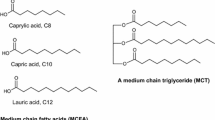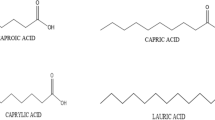Abstract
A series of five C18 unsaturated fatty esters (1–5) containing anL-amino acid residue (glycine, alanine, valine, leucine, phenylalanine) was prepared from methyl 12-amino-9-cis-octadecenoate and five methylN-stearoyl-amino acid ester derivatives (6–10) from stearoyl chloride and the sameL-amino acids. The infrared analysis of compounds 1–5 showed characteristic absorption bands at 3300 and 1665 cm−1 for the amino and amido functions, while the amido function in compounds 6–10 gave absorption bands at 3300 and 1680 cm−1. The position of the amido group (peptide linkage) in compounds 1–5 was readily determined by mass spectral analysis.1H nuclear magnetic resonance (NMR) analysis showed a doublet at 7.15 ppm for the amide proton (NHCO) in compounds 1–5, while in compounds 6–10 the amide proton signal appeared at 6.0 ppm. In13C NMR, the amido carbonyl resonance appeared at 171–175 ppm. In compounds 1–5 the effect of the amide function on the ethylene carbon (C-9) gave a signal at 124.1–125.3 ppm, while the remaining ethylenic carbon appeared at 131.9–132.5 ppm. The methine carbon (C-12) of the alkenyl chain was shifted to 48.4–49.8 ppm, and the assignment of the various carbon nuclei in the amino acid residue was readily achieved. In the methylN-stearoylamino acid ester derivatives (6–10), the methine carbon adjacent to the amido system and alpha to the carbomethoxy group appeared between 41.2–57.0 ppm depending on the type of alkyl group present in the amino acid moiety. The phenyl system in compounds 5 and 10 was confirmed by the13C signals in the 127–136 ppm range and by the proton signals in the 7.0–7.27 ppm region.
Similar content being viewed by others
References
Jungermann, E., Gerecht, J.F., and Krems, I.J. (1956)J. Am. Chem. Soc. 78, 172–174.
Iyer, V.N., Sheth, G.N., and Subramanyam, V.V.R. (1982)J. Indian Chem. Soc. 59, 856–859.
Fosdick, L.S., Calandra, J.C., Blackwell, R.O., and Burrill, J.H. (1953)J. Dental Research 32, 486.
Beger, J., Neumann, R., and Seibt, A. (1986)Tenside Surfactants Deterg. 23, 156–159.
Takahashi, K., Tanaka, F., and Motomura, K. (1984)Bull. Chem. Soc. Jpn. 57, 944–947.
Konova, N.I., Puchkova, L.I,, and Akimova, A.A. (1982)Khlebopek. Konditer. Prom-st., 20–21 (Chem. Abstr. 97, 4884, 1982).
Konova, N.I., Akimova, A.A., and Puchkova, L.I. (1986)Khledbopek. Konditer. Prom-st. 27–29 (Chem. Abstr. 104, 223874, 1986).
Gunstone, F.D. (1954)J. Chem. Soc., 1611–1616.
Lie Ken Jie, M.S.F., and Lao, H.B. (1987)Chem. Phys. Lipids 45, 65–74.
Sheehan, J.C., Chapman, D.W., and Roth, R.W. (1952)J. Am. Chem. Soc. 74, 3822–3825.
Author information
Authors and Affiliations
About this article
Cite this article
Lie Ken Jie, M.S.F., Lao, H.B. & Leung, D.W.Y. Preparation and physical properties of some C18 unsaturated fatty esters containingL-amino acid residues and methyl esters ofN-stearoylamino acids. Lipids 25, 260–266 (1990). https://doi.org/10.1007/BF02544385
Received:
Accepted:
Issue Date:
DOI: https://doi.org/10.1007/BF02544385




